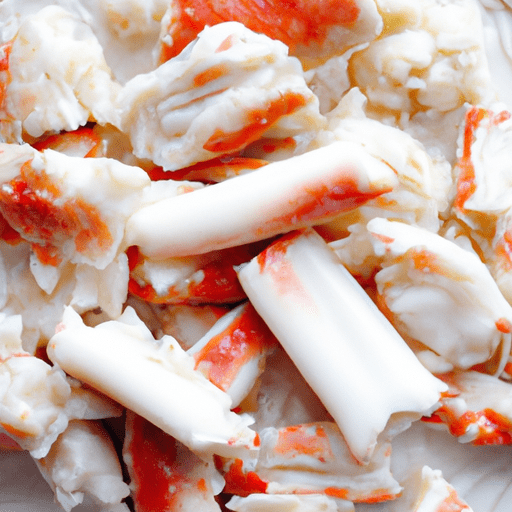The Delightful World of Crab Meat: A Seafood Sensation
If you’re a fan of seafood, then crab meat is undoubtedly one ingredient that shouldn’t be missed. With its delicate flavor, succulent texture, and versatility in the kitchen, crab meat has become a favorite amongst food enthusiasts. Whether enjoyed in luxurious recipes or humble dishes, crab meat brings its unique taste and nutritional value to the table.
A Taste of Delicacy
Crab meat boasts a delightful taste that effortlessly blends sweetness with a hint of brininess. Each mouthful delivers a burst of flavor that is both subtle and satisfying. The meat itself is tender and has a slightly firm texture, making it a joy to savor. Its natural sweetness pairs well with a variety of ingredients, allowing for endless culinary possibilities.
Cooking with Crab Meat
Crab meat is a fantastic addition to a multitude of dishes, catering to both everyday meals and special occasions. Here are some popular ways to enjoy this delectable ingredient:
Crab Cakes: A classic dish that showcases the versatility of crab meat. Combine the meat with breadcrumbs, herbs, and spices, then pan-fry until golden brown. The crispy exterior and tender interior make these cakes irresistible.
Crab Salad: A refreshing and light option, crab salads are beloved for their bright flavors. Tossed with fresh greens, juicy fruits, and a zesty dressing, crab meat brings a touch of elegance to any salad bowl.
Crab Soup: Whether it’s a creamy bisque or a nourishing broth, crab lends its rich flavor to soups. Its unique taste infuses the soup, creating a comforting and satisfying dish.
Crab Pasta: Elevate your pasta dishes by adding crab meat for a burst of seafood flavor. Tossed with linguine, creamy alfredo sauce, and a sprinkle of grated cheese, it creates a luxurious and indulgent meal.
Nutritional Value
Besides its exceptional taste, crab meat also offers an array of health benefits. It is an excellent source of high-quality protein, making it a valuable ingredient for those looking to fuel their bodies. Additionally, crab meat contains essential vitamins and minerals, including vitamin B12, zinc, and selenium. These nutrients contribute to improved brain function, boosted immunity, and optimal thyroid health.
A Peek into History
Crab meat has a fascinating history deeply intertwined with maritime cultures and traditions. Native to the Earth’s oceans and coastal regions, crabs have been cherished for centuries. In many coastal communities, catching and consuming crabs are integral parts of local culinary heritage.
The popularity of crab meat extends throughout various cuisines worldwide. From the famous Chesapeake Bay blue crabs in the United States to the Dungeness crabs of the Pacific Northwest, crab has become an icon of coastal gastronomy.
Fun Facts about Crab Meat
To pique your curiosity, here are some interesting tidbits about crab meat:
- The largest crab in the world is the Japanese spider crab, known for its impressive leg span of up to 12 feet.
- Soft-shell crabs are crabs that have molted their old shells, leaving behind a soft and edible exoskeleton.
- The color of crab meat can vary between species, ranging from snowy white to a deep orange hue.
- The saying “crack a crab” originates from the act of breaking open the hard shell to reveal the succulent meat within.
Whether steamed, grilled, or incorporated into gourmet creations, crab meat continues to captivate taste buds and inspire innovative dishes. Its delicate yet distinctive flavor profile, combined with its numerous cooking possibilities, makes it a treasure of the sea guaranteed to satisfy any seafood lover’s cravings. So the next time you come across crab meat, don’t hesitate to embrace the ocean’s bounty and indulge in this seafood sensation.
Interesting Facts about Crab Meat:
Origin: Crab meat is derived from various species of crabs found in oceans, freshwater bodies, and some brackish water environments. It has been a popular seafood ingredient for centuries.
Common Uses: Crab meat is commonly used in various cuisines around the world. It is often used in dishes such as crab cakes, crab bisques, crab salads, crab-stuffed mushrooms, and crab soup. It is also a popular ingredient in sushi and other seafood dishes.
Nutritional Benefits: Crab meat is known for being a lean source of protein. It is also low in calories and fat, while being rich in vitamins and minerals. Additionally, crab meat contains omega-3 fatty acids, which are beneficial for heart health.
Unique Properties: One of the unique properties of crab meat is its delicate and sweet flavor. The texture can vary depending on the species, with some being more tender and others being firmer. The meat is typically white, but some species have a reddish tint.
Historical Significance: Crabs have been a part of the human diet for thousands of years. They have been an important food source for many coastal communities throughout history. In some cultures, the catching and cooking of crabs is accompanied by various rituals and traditions.
It’s important to note that while crab meat can be a delicious and versatile ingredient, it is also important to consider sustainable fishing practices and choosing crab products from sustainable sources to help protect the long-term viability of crab populations and ocean ecosystems.




Use the share button below if you liked it.
It makes me smile, when I see it.